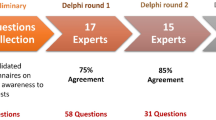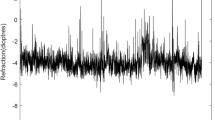Abstract
Objectives
This paper evaluates the accuracy of the Eye-N-JOY (ENJ), a novel device (Patent no. US 9844317 B2), for identifying the presence of amblyopic risk factors. This device was developed to assess both visual acuity, ocular alignment, and eye movement; all while watching images on a tablet screen.
Methods
A prospective, single-center, comparison study. Participants were examined by the ENJ first and then underwent a comprehensive full eye examination by pediatric ophthalmologists including cycloplegic refraction. Both the technician operating the ENJ and the physicians were masked to each other’s findings. Children aged 18–72 months (1.5 to 6 years) attending a tertiary medical center for a full standard pediatric ophthalmology examination were included. The visual acuity and alignment were compared between the ENJ and the gold standard full ophthalmologic examination. The differences were noted, and the sensitivity and specificity were calculated.
Results
A total of 51 children were enrolled, 33 (64.7%) girls, aged 18–72 months. All children successfully completed the examination by the ENJ. No significant difference between the ENJ and the reference examination was detected in visual acuity measurements in both eyes (Pv = 0.553 for the right eye and 0.803 for the left). Overall agreement between all referral indications between the ENJ and reference examination was 84.3%, with 90.9% agreement in VA referral criteria and 90.1% in alignment referral criteria.
Conclusions
Eye-N-Joy can reliably examine both visual acuity and ocular misalignment in verbal and pre-verbal children.
Similar content being viewed by others
Log in or create a free account to read this content
Gain free access to this article, as well as selected content from this journal and more on nature.com
or
References
Wu C, Hunter DG. Amblyopia: diagnostic and therapeutic options. Am J Ophthalmol. 2006;141:175–84.
Gunton KB. Advances in amblyopia: what have we learned from PEDIG trials?. Pediatrics. 2014;131:540–7.
Village G. Vision screening for children 1 to 5 years of age: US preventive services task force recommendation statement. Pediatrics. 2011;127:340–6.
Donahue SP, Nixon CN. Visual System Assessment in Infants, Children, and Young Adults by Pediatricians. Pediatrics. 2016;137:28–30.
Arnold RW, Miller JM. Vision in Preschoolers Study [1] (multiple letters). Ophthalmology. 2004;111:2313–5.
Kirk VG, Clausen MM, Armitage MD, Arnold RW. Preverbal photoscreening for amblyogenic factors and outcomes in amblyopia treatment: early objective screening and visual acuities. Arch Ophthalmol. 2008;126:489–92.
Teed RG, Bui CM, Morrison DG, Estes RL, Donahue SP. Amblyopia therapy in children identified by photoscreening. Ophthalmology. 2010;117:159–62.
Jeon HS, Choi DG. Stereopsis and fusion in anisometropia according to the presence of amblyopia. Graefe’s Arch Clin Exp Ophthalmol. 2017;117:159–62.
Buckley JG, Panesar GK, MacLellan MJ, Pacey IE, Barrett BT. Changes to control of adaptive gait in individuals with long-standing reduced stereoacuity. Investig Ophthalmol Vis Sci. 2010;51:2487–95.
Engel-Yeger B. Evaluation of gross motor abilities and self perception in children with amblyopia. Disabil Rehabil. 2008;30:243–8.
Zipori AB, Colpa L, Wong AMF, Cushing SL, Gordon KA. Postural stability and visual impairment: assessing balance in children with strabismus and amblyopia. PLoS One. 2018;13:0205857.
Garretty T. Final visual outcomes and treatment received for children referred from a UK primary school visual screening program: a comparison of an orthoptic-led program with orthoptic-delivered services. Strabismus. 2017;25:184–90.
Solebo AL, Rahi JS Childhood vision screening. External review against programme appraisal criteria for the UK National Screening Committee. Version: Final (2019).
Solebo, Ameenat Lola, Phillippa M. Cumberland, Jugnoo S. Rahi. Whole-population vision screening in children aged 4–5 years to detect amblyopia. Lancet. 2015;385:2308–19.
Lempert P. Amblyopia and photoscreening. Ophthalmology. 2010;117:1661.
De Juan V, Sanchez I, Ortiz-Toquero S, Martin R Advantages, limitations, and diagnostic accuracy of photoscreeners in early detection of Amblyopia: a review. Clin Ophthalmol Volume 10, 2016.
Ruben JB, Granet DB, Blocker RJ, Bradford GE, Karr DJ, Lueder GT, et al. Instrument-based pediatric vision screening policy statement. Pediatrics. 2012;130:983–6.
Loudon SE, Rook CA, Nassif DS, Piskun NV, Hunter DG. Rapid, high-accuracy detection of strabismus and amblyopia using the pediatric vision scanner. Investig Ophthalmol Vis Sci. 2011;52:5043–8.
Jost RM, Stager D, Dao L, Katz S, McDonald R, Birch EE High specificity of the Pediatric Vision Scanner in a private pediatric primary care setting Presented in part as a poster 41st Annual Meeting of the American Association for Pediatric Ophthalmology and Strabismus, New Orleans, Louisiana, March 25–29, 201. J AAPOS 19, 521-5 (2015).
Wallace DK, Morse CL, Melia M, Sprunger DT, Repka MX, Lee KA, et al. Pediatric Eye Evaluations Preferred Practice Pattern®: I. Vision screening in the primary care and community setting; II. Comprehensive ophthalmic examination. Ophthalmology. 2018;125:184–227.
Acknowledgements
The hospital was financially compensated for this project, The study investigators did not receive any financial nor other incentives. The company or the hospital did not have access to the data and did not review the paper.
Author information
Authors and Affiliations
Contributions
All authors collected the data. DMH,ABZ and CS designed the study. NG, AR and DMH made the statistical analysis. NG, AR, ABZ and DMH wrote the paper. All authors have authorized the paper.
Corresponding author
Ethics declarations
Competing interests
The authors declare no competing interests.
Additional information
Publisher’s note Springer Nature remains neutral with regard to jurisdictional claims in published maps and institutional affiliations.
Supplementary information
Rights and permissions
About this article
Cite this article
Rosenblatt, A., Stolovitch, C., Gomel, N. et al. A novel device for assessment of amblyopic risk factors in preverbal and verbal children–a pilot study. Eye 36, 2312–2317 (2022). https://doi.org/10.1038/s41433-021-01860-z
Received:
Revised:
Accepted:
Published:
Issue date:
DOI: https://doi.org/10.1038/s41433-021-01860-z



